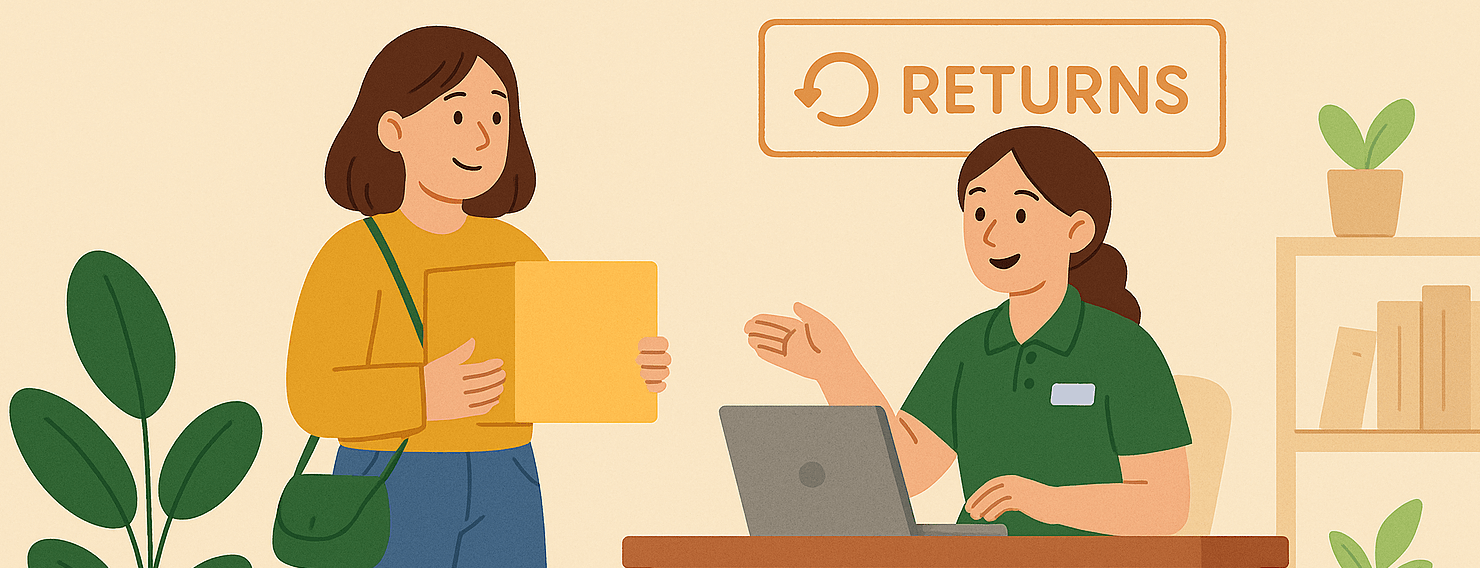Table of Contents
Refunds usually feel like failure – “We lost the sale.” Yet, flip the lens: a refund is really a second first-impression. Handle it well and the shopper’s last memory of your brand is helpful, not hassle.
That’s the heart of the refund customer experience: the part of CX almost no one talks about, yet it decides whether money ever flows back.
A quick reality check:
- Shoppers will give you another shot. Invesp found that 92 % of consumers say they’ll buy again if the return process is easy.
- Brands rarely ask what went wrong. Most companies survey pre-purchase but stay silent after a refund leaving insight (and future revenue) on the table.
So, instead of treating refunds as the end of the journey, treat them as the start of your loyalty program. In this article, we’ll show how post-refund feedback, smart segmentation, and simple “refund recovery” tactics turn a lost sale into the next one.
Key Takeaways
- Handled well, a refund can actually increase trust and loyalty rather than end the relationship.
- Failing to follow up post-refund creates a huge churn risk and a missed chance to learn and improve.
- Simple, empathetic surveys can uncover why the customer left and what might bring them back.
- From a thank-you message to smart re-engagement based on refund reason, tailored outreach makes customers feel valued.
- Refund recovery tactics like delayed re-engagement, social proof, and VIP treatment can turn returners into repeat buyers.
- Tools like Loop Returns, Klaviyo, and Retently help scale follow-up with care and relevance.
- A great post-refund experience can turn a frustrating moment into a customer story worth sharing.
Why Refunds Happen And Why That’s Okay
First, let’s remove the stigma: most refunds aren’t a vote of no-confidence in your brand. They’re usually about fit, timing, or simple buyer’s remorse. Narvar’s annual State of Returns report shows that the top reasons shoppers send items back are wrong size/fit, arrived too late, product not as described and changed my mind.
In other words, the majority of refunds stem from practical issues you can fix or at least empathize with. That’s why forward-thinking retailers don’t view returns as the end of the relationship. In fact, 70% of shoppers who return items in-store go on to buy something else during that same visit. That’s not churn, that’s opportunity.
So, instead of treating a refund as a setback, treat it as a service moment:
- Wrong size? Offer a sizing guide and free-exchange label.
- Late delivery? Apologize, refund shipping, and suggest a faster option next time.
- Product not as described? Acknowledge the mismatch, clarify expectations, and recommend alternatives with better-fit visuals.
- Change of mind? Thank them for trying you out, then show them something that really fits their needs.
When you frame refunds this way, you’re not losing a sale; you’re proving your brand is trustworthy and flexible. And that mindset shift turns a potential churn point into the first chapter of a new (and often more loyal) customer story.
The Real Problem: The Silent Good-bye
Here’s the hard truth about refunds: most brands process the return, issue the credit, and… that’s it. The conversation ends, the customer drifts away, and a perfectly salvageable relationship goes silent.
That silence is expensive. Industry research puts the cost of acquiring a new shopper at 5-7 times the cost of keeping an existing one, yet ecommerce teams still treat refunds like a dead end instead of a restart.
Customers notice. A 2024 NRF & Happy Returns study found that 67 % of shoppers say a negative return experience would discourage them from buying from that retailer again. In other words, a clunky or impersonal refund doesn’t just end the sale; it can end the shopper’s loyalty.
And here’s the opportunity gap: while almost every retailer now tracks pre-purchase metrics, very few bother to collect post-refund feedback or attempt a re-engagement. In the same NRF survey, barely two-thirds of merchants (68%) even plan to upgrade their returns experience in the next six months, and the study makes it clear most upgrades focus on logistics – box-free drop-offs, faster credits, not on follow-up conversations.
The math is brutal:
- Churn from one silent goodbye → lost customer lifetime value.
- A single personalised follow-up → chance to recover that value at a fraction of the acquisition cost.
Yet because the post-refund moment isn’t tracked in most CRMs (or dashboards), it slips through the cracks. No feedback loop, no save attempt, just revenue quietly walking out the door.
Key takeaway: Refunds don’t kill loyalty; ignoring customers after the refund does. In the next section, we’ll look at simple, data-driven ways to turn that silence into a conversation that wins shoppers back.
Retaining Refunding Customers: What Actually Works
Most people who ask for a refund aren’t lost forever, they’re waiting to see how you handle the moment. Step one is simply asking how it went, but doing it in a way that feels human, not robotic.
1. A Post-Refund Survey That Doesn’t Suck
Let’s be honest, most post-purchase surveys feel like interrogations. The best ones? They’re short, empathetic and timed just right.
Why it matters
Teams that gather feedback within 24 hours of a refund see higher response rates than those that wait a week. Acting fast keeps the memory fresh and shows you care. More importantly, it’s your window to measure post-refund CSAT (how satisfied they were with the return experience) and even NPS – how likely they are to promote your brand after you handled a problem.
How to do it
| 🚀 Do | 🚨 Don’t |
|---|---|
| Send the survey after the refund confirmation email not inside it. | Ask 10 questions; you’ll lose them after the first two. |
| Keep it 2-3 empathetic prompts. | Phrase questions to assign blame. |
| Offer a small “thank-you” (loyalty points, discount on next order). | Make the incentive conditional on a positive response. |
Sample questions that work
- “How was the return process for you today?”
(1-5 scale, add a text box for details.) - “Was there anything we could’ve done to help you keep the product?”
(Open-ended; shows you’re listening, not judging.) - “Would you shop with us again if the issue you faced was resolved?”
(Yes / No / Maybe; gives you a re-engagement flag in the CRM.)
This kind of language doesn’t just collect data, it builds trust. You’re showing the customer that you care, not just about the product, but about their experience.
Pro tip: Tag each response by refund reason (size, shipping, product quality). When you email that shopper next, you’ll know exactly what to fix or highlight.
Next up, we’ll dive into the Personalized Thank-You and AI-Powered Segmentation, the two moves that turn good survey data into second-chances and future sales.
2. Personalized Thank-You (Yes, Even After a Refund)
A refund shouldn’t be the last thing a customer hears from you. A quick, genuine “thanks for giving us a try” can flip the script from goodbye to see you again.
- Make them feel heard, not dismissed
Drop the boilerplate. Send a short, human note from a real name – bonus points if you reference the exact item they returned or the hiccup they ran into. It shows you were actually listening.
“We’re sorry the fit wasn’t perfect on the Classic Hoodie. Thanks for giving us a shot. Let us know if we can help find the right size next time.”
- Sweeten it (just a little)
Small gestures go a long way: a free-shipping code, a size-swap voucher, or early access to a new drop. These don’t cost much, but they build goodwill that’s hard to measure and even harder to forget.
And customers welcome the outreach: a recent study flagged by Constant Contact found that 81% of consumers are open to post-purchase emails or texts, yet 27% of SMBs never follow up. Big gap, easy win.
One rule of thumb: keep the freebie proportional. You’re not buying their love, you’re showing appreciation and inviting them back.
Because when a shopper feels thanked not ignored, they’re far more likely to hit “Add to Cart” on their return visit.
3. AI-Powered Segmentation for Smart Re-Engagement
Not every refund is the same, so your follow-up shouldn’t be either. Some brands choose to tag every return reason in their CRM – “size/fit,” “arrived late,” “changed mind” – and let AI build micro-segments on the fly. That way the next message feels like help, not a blast.
- If “size/fit” was the trigger, the follow-up email includes a quick video on sizing, a fit-finder quiz, and a free-exchange coupon.
- If delivery ran late, the flow highlights faster shipping options and a one-click upgrade.
- If they simply changed their mind, you showcase new arrivals that match their browsing history.
Why bother? Because shoppers really will give you a second chance. And when those follow-ups are segmented instead of one-size-fits-all, the payoff is huge: marketers report up to a 40% lift in revenue from segmented campaigns compared with generic sends.
AI does the heavy lifting – reading refund tags, predicting what each customer cares about next, and triggering the right content automatically. All you have to do is make sure the human benefit is front and center. That’s how you move a refund conversation from “goodbye” to “see you again soon.”
Refund Recovery Tactics: How to Win Them Back
When the refund is done and dusted, your job isn’t. This is the moment to deploy refund recovery tactics – proven ways to turn a one-time returner into a loyal repeat-buyer.
Tactic 1: Time the Re-Engagement Right
A “We miss you – here’s 10 % off!” email the very next morning feels spammy. Give shoppers a breather, then follow up with something that actually helps. Studies found that most shoppers are open to another purchase 7-14 days after a smooth refund; hit that window with a relevant offer and you’ll catch them when they’re ready, not irritated.
Tactic 2: Use Social Proof to Rebuild Trust
If sizing was the issue, share fit-finder tools and reviews from customers with similar measurements. If quality was the question, surface five-star testimonials and a video of your upgraded product. Social proof reassures shoppers that their next try will end better than the last.
Tactic 3: VIP Their Next Experience
Flag refunders in your CRM so the next order cues extra care: priority picking, nicer packaging, or a “concierge” chat option. Small upgrades feel like an apology without saying, “We’re sorry” and they cost far less than acquiring a brand-new customer.
Tactic 4: Close the Loop Publicly (When Needed)
If the refund complaint played out on social media, don’t let the story end there. After you fix the root cause – better sizing chart, faster shipping – comment publicly or post a short update: “Here’s what we changed because you spoke up.” Transparency turns critics into advocates faster than any discount code.
Handled together, these tactics transform refunds from revenue leaks into relationship builders, proving a refund can be the start of your next sale, not the end of the line.
From Refund to Referral: It’s Possible
A refund doesn’t have to read like “The End.” Handled well, it can become Chapter One of a far better story, one that customers actually share.
Chewy’s famous “flowers + refund” moment is a perfect case. When Wisconsin customer Anna Brose’s dog, Gus, passed away, she asked Chewy if she could return an unopened bag of prescription food. Chewy refunded the order immediately, told her to donate the food to a local shelter and sent a bouquet of flowers with a handwritten note of condolence. The gesture went viral; Brose’s thank-you tweet collected thousands of likes and news coverage in The Washington Post.
The result? Brose became a loud, lifelong advocate, exactly the kind of customer every brand wants. One refund, a bit of empathy, and Chewy gained priceless word-of-mouth.
What makes this work?
- It feels personal. A real note, not a template.
- It solves the practical problem. Full refund fast.
- It adds unexpected value. Flowers + “donate the food” turns loss into goodwill.
- It invites future trust. Brose has said publicly she’ll keep buying from Chewy.
The lesson is simple: if you treat a refund as the start of a conversation, not the finish, customers will remember, return, and even refer you. All it takes is listening, empathy, and one small, thoughtful gesture.
Tools That Help Make It Happen
Turning a refund into a retention win doesn’t have to be manual or time-consuming. The right tools can help you create a smart, seamless post-refund experience that runs on autopilot (but still feels human).
- Post-Refund Automation Platforms: Want to follow up after a return without annoying your team (or your customer)? Tools like Klaviyo, Gorgias, and Loop Returns make it easy to trigger personalized flows based on refund events. You can send an empathetic thank-you email, a discount for a second try, or sizing help exactly when it’s needed.
- Feedback Tools with Smart Triggers: Not all surveys are created equal. Tools like Retently let you launch short, well-timed surveys after a refund is processed. No long forms, no guilt trips, just a quick “Hey, how’d we do?” that helps you spot friction and fix it fast.
- CRM Tagging & Segmentation: For deeper re-engagement, platforms like Shopify or HubSpot let you tag refunding customers by reason and funnel them into the right win-back campaigns later. Whether it’s sizing issues, slow shipping, or the wrong product altogether, your next message can feel tailor-made.
Bottom line: you don’t need a huge team or fancy loyalty program to turn refund moments into second chances, you just need the right tools (and a little empathy).
Conclusion: Treat Refunds as a Start, Not a Stop
Refunds don’t have to be red flags on your balance sheet, they can be green lights for loyalty. When you treat every return as a high-leverage customer-experience moment, you flip the story from “lost sale” to “second chance.”
Remember the playbook:
- Ask, don’t accuse: A two-question, post-refund survey shows you care and surfaces easy fixes.
- Say thanks with heart: A simple note (plus free shipping or a small credit) makes customers feel heard, not hurried out the door.
- Segment smartly. Tag the refund reason and follow up with content that actually solves the original problem whether that’s sizing tips, faster delivery options, or product swaps.
- Use social proof and VIP touches: Show real-life success stories and add a little “wow” to their next order.
- Close the loop publicly if needed: Show customers (and onlookers) that you listen, learn, and improve.
Your next step? Audit your current refund flow from end to end. Ask yourself:
- Do we collect post-refund feedback, or do we let the customer vanish?
- Is there a personalized follow-up, or just radio silence?
- Can a returning shopper see we’ve fixed the issue that made them leave?
If any answer is “maybe,” you’ve just found your growth project. Tighten the loop, add empathy, and watch refunds transform from final chapter to future sale.


































 Christina Sol
Christina Sol 




 Greg Raileanu
Greg Raileanu 